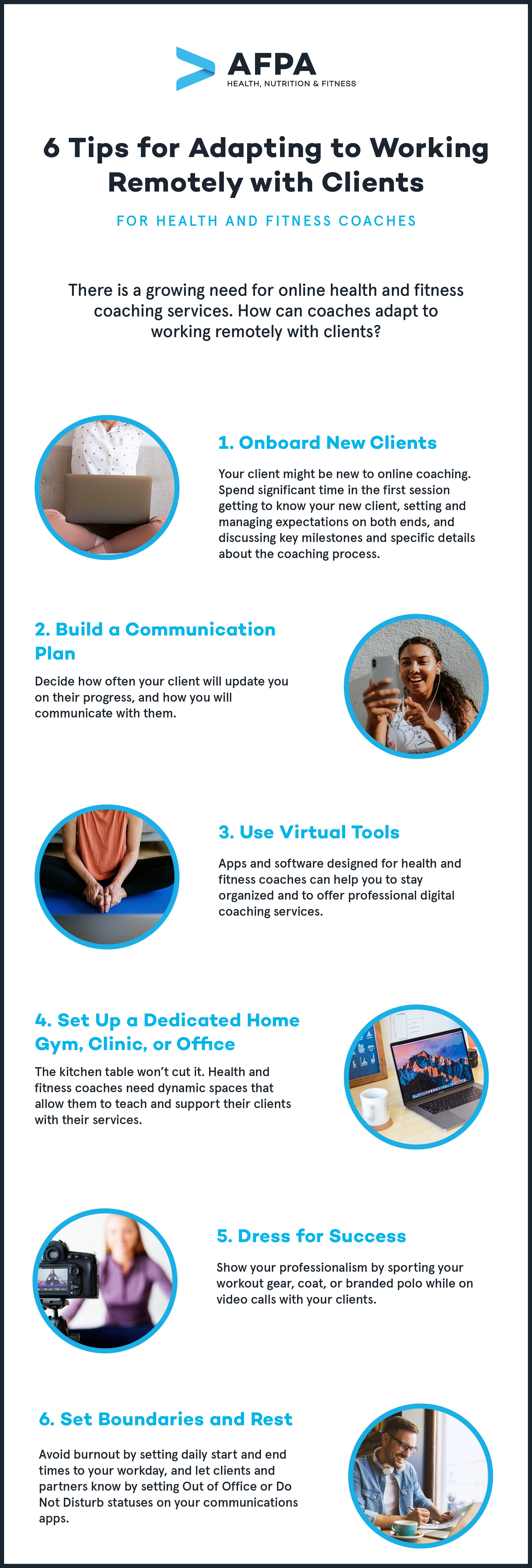Most professionals have the desire to be able to work from home. In theory, what’s not to like? There is no commute time, you get some extra sleep, you get to work in your PJs, and you get to work in a comfortable space you can truly call your own.
Before the COVID-19 pandemic, when masses of companies and organizations shifted from having in-person to remote workforces, surveys showed that 80% of employees had the desire to work from home at least some of the time and were even willing to take a pay cut to do so.
Leaders in the health and fitness industry have shifted to delivering their services through online platforms, allowing coaches and health and wellness business owners the flexibility to work from wherever they want to.
Adapting to working remotely with clients is not without challenges. Whether you are moving your business online for the first time or want to improve your remote coaching skills, here we offer six tips that will help you crush the digital coaching industry.
If you want more information about bringing your coaching business online, check out these tools and tips.

If you want more information on how to build your online personal training business from the ground up, check out this guide. If you have a nutrition component to your business, this article offers useful tips that will help you grow your business, as well.

The Essential Business Course for Health and Wellness Entrepreneurs
Gain the skills needed to build and run a thriving, lucrative health and wellness business.
Coaching: A Digital Industry?
The coaching industry is shifting as a result of several forces that are pushing for more digitally based services. Some of the reasons for this shift include:
Widespread Access to the Internet
In the US, 81% of the total population and 96% of people from 18 to 29 own a smartphone. It is estimated that about half of the world population owns a smartphone. This means that most people have the potential to connect to the internet at any moment of the day to access communication resources, information, and entertainment and media platforms.
Satisfies a Desire for On Demand Services
Beginning with the millennial generation, there is a greater desire to do things efficiently and meet needs quickly.
For many people, the idea of catching a train to the bank and waiting in line is unappealing, especially if they have the option of online banking through an app with no wait time. The same applies to coaching services. If a client can pick up their phone and start their personalized exercise routine as it was programmed into the app or connect to a video call while finishing up breakfast at home, they will usually prefer those options.
Offers More Options
Now, distance doesn’t limit where you can take courses or whether you can see your best friend from high school. Digital technologies have broken down borders and shortened distances. In the coaching world, that means clients can choose from coaches from all over the world based on whose service offerings they like best, rather than settling for whichever coach is available locally. While entering the digital world will mean you have greater competition, it will also mean the number of potential clients is practically endless.
Allows for Social Distancing
The COVID-19 pandemic came at a time when there were several alternatives to meeting in person for classes, sessions, meetings, and appointments, thanks to digital communications and e-learning technologies.
The social distancing recommendations that have resulted from the COVID-19 pandemic have pushed people to seek out these online services. In some cases, when their original providers do not offer digital alternatives to their services, they will seek out someone who does.
6 Tips and Hacks for Working Remotely with Clients
Given this context, how can coaches adapt to working remotely with clients? Here are six tips and hacks that will help you make the transition or boost your existing digital services.
Onboard New Clients
Onboarding refers to the process where you are inducting your client into the coaching process. Rather than jump right into talking about meal plans, lifestyle modifications, and fitness routines, spend significant time in the first session getting to know your new client, setting and managing expectations on both ends, and discussing key milestones and specific details about the coaching process.
Build a Communication Plan
This is important for both clients with whom you originally worked in a face-to-face fashion as well as for clients with whom you’ve always worked online. Decide how often your client will update you on their progress, and how you will communicate with them (phone, text message, video call, via an app or platform, email, etc.).
A clear communication plan is important not only to make sure you can support your client in their progress but also so that you are clear with your boundaries. One of the challenges of 100% virtual coaching businesses is that clients may expect you to be on demand to answer their questions and offer support, and you can be at risk of burnout.
Use Virtual Tools
The world of support tools for health, wellness, and fitness coaches has expanded significantly as the digital wellness market has grown exponentially. These tools could radically change how you do business so you can stay organized; capture more clients; and offer better, more personalized services.
Some of these apps and services include Practice Better, True Coach, and Vagaro. We have comprehensive lists of apps and software that personal trainers, nutrition coaches, and health coaches can use to make working remotely easier while helping grow their business.
Set Up a Dedicated Home Gym, Clinic, or Office
Health, nutrition, and fitness coaches often have a different workspace than most remote workers. In addition to needing a space to set down the computer and design fitness and meal plans, coaches often need profession-specific tools, making it impractical to use the kitchen table for remote work.
For example, fitness coaches might have to be in live sessions with clients, or they might need a space to record workout sessions to upload onto a platform. Nutrition consultants might need a space to teach clients how to cook or tools to show them how to measure out portions.
The more dynamic activities that come naturally to health and wellness coaches require you to put thought into your workspace.
Here are some things to consider: Make sure there is no echo, good lighting, a pleasant background, and a place to easily set up your computer or phone.
Dress for Success
Just because you are working with clients remotely doesn’t mean they will be okay with you working in your pajamas. Just like you would want your clients to be in the appropriate workout attire to take on the day’s routine, it is important that you project your professionalism and readiness through how you dress.
Set Boundaries and Rest
Just because your clients are at home and have more flexible hours doesn’t mean you have to be on call all of the time. Set daily “online times” and make sure your appointments line up with those times. Embrace “Do Not Disturb” statuses and functions on your messaging systems to enforce those times.
When you are offline, take time to rest, recover, and take care of non-work responsibilities. These will help you avoid burnout and be your best self.
Main Takeaways
Whether you are looking to migrate to an online business platform to continue working with clients who have moved away or are practicing social distancing or because you want your business to grow, know that the health and wellness industry is rooting for you.
The transition can be difficult, but by implementing some key strategies to help with communication, organization, and personal boundaries, you may find that the digital health industry is a great opportunity to refresh your business and make an even greater impact.

The Essential Business Course for Health and Wellness Entrepreneurs
Gain the skills needed to build and run a thriving, lucrative health and wellness business.



